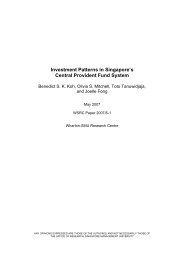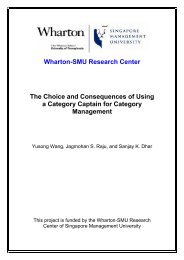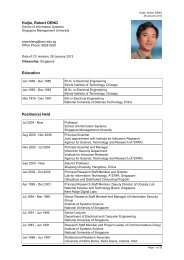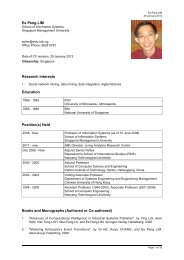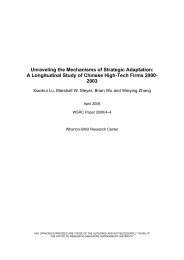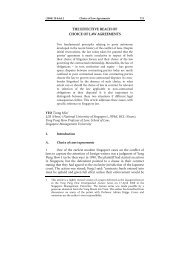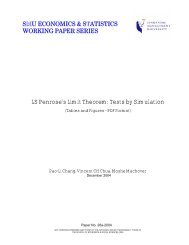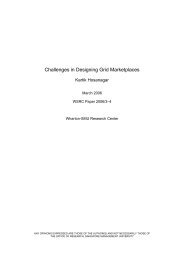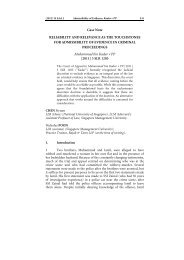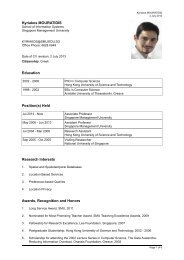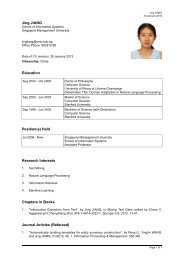The Benefits of Volume-Conditional Order-Crossing - Singapore ...
The Benefits of Volume-Conditional Order-Crossing - Singapore ...
The Benefits of Volume-Conditional Order-Crossing - Singapore ...
You also want an ePaper? Increase the reach of your titles
YUMPU automatically turns print PDFs into web optimized ePapers that Google loves.
or do not wish to monitor. 6<br />
Our model <strong>of</strong> the crossing network is more stylized than the above description; it captures the<br />
main features and economic benefits <strong>of</strong> this market in a one-period setting that keeps the analysis<br />
tractable. In particular, we assume that the conditional market clears if the total number <strong>of</strong> buy<br />
orders and sell orders placed in that market both exceed ψ, the volume condition for the market.<br />
To capture the idea that the conditional market’s price adjusts with that in the continuous market,<br />
we assume that, upon the volume condition being reached, the orders are crossed at a price <strong>of</strong> zero,<br />
which in the model is always the mid-quote price. If one side (say the buy side) in this market<br />
contains more orders than the other then we assume that the appropriate fraction <strong>of</strong> the buy orders<br />
are randomly chosen and cleared against all the sells. This captures the idea that traders do not<br />
know where their orders are in the conditional market’s queue and so, assuming time priority,<br />
realize that their orders, if placed on the heavier side <strong>of</strong> the book, may require the conditional<br />
market to clear more than once before they can be crossed. Although every trade between a buyer<br />
and a seller <strong>of</strong> the risky security takes place at a price <strong>of</strong> zero, this transaction is not free for either.<br />
In particular, we assume that every buyer or seller whose order gets crossed with that <strong>of</strong> another<br />
trader is charged a pre-announced order-crossing fee <strong>of</strong> c by the exchange or market-maker in charge<br />
<strong>of</strong> the trading venue.<br />
As our model shows, the volume condition that is chosen for the market is crucial. If ψ is set<br />
to a large value, the conditional market is unlikely to ever clear, and so the conditional market<br />
becomes an unattractive venue. If ψ is set to a small value, then the conditional market becomes<br />
an attractive alternative to the continuous market and may even become the dominant trading<br />
venue, as traders are almost sure that it will always clear. As our analysis will show, setting ψ<br />
to an intermediate value allows trader types to be sorted and can generate Pareto improvements<br />
over the situation in which only the continuous market operates. Similarly, the order-crossing fee<br />
c must be set strategically for the conditional market to be useful. Indeed, the conditional market<br />
is unattractive when c is large, and too attractive when c is low.<br />
3.2 <strong>The</strong> <strong>Conditional</strong> Market as a Stand-Alone Trading Venue<br />
To illustrate how the conditional market functions, we start by modelling it in isolation. That is,<br />
let us first assume that shares can only be traded in a conditional market and that trading in a<br />
6 Of course, this also means that this crossing network free-rides from the price discovery process <strong>of</strong> the continuous<br />
market, a feature <strong>of</strong> crossing networks that has been discussed by O’Hara (2004) and Stoll (2006), among others. As<br />
we show later, when appropriately chosen, the volume condition will ensure that the crossing network will not harm<br />
and might even improve price discovery.<br />
9



